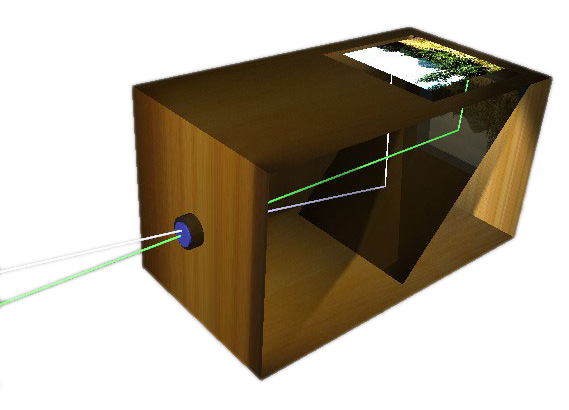|
Teach
With Bigshot |
Build a Lens CameraNext
Prev
Some of the earliest cameras were boxes that used a lens to form an image onto a viewing surface. Today's cameras work in a very similar way, but the viewing window has been replaced by an image sensor. Follow the instructions below to build your own camera from easy-to-find components. Things You Need
Close-up Lens

Tissue box

Cardboard Tube

Tracing paper

Pen or pencil

Scissors

Tape

Ruler
(Touch or hover over each item for more information)
How To Make ItThings To Try
Point the camera to a bright object such as a TV screen or a window. You will see an image of it form on the tracing paper. 
Turn the camera towards a scene with two or more objects at different distances. If you try to focus on one of the objects, the others will become blurred. How It WorksA lens camera can be thought of as an upgraded pinhole camera. Pinhole cameras don't do a good job of forming bright images because only a small amount of light is able to pass through the tiny hole. Lenses, on the other hand, are designed to receive substantially more light from a scene and focus it to form an image. Lenses used in cameras, such as the one described above, are shaped in such a way that incoming rays of light from a scene point are bent (or refracted) towards a single point.
Objects that are at the same distance from the lens are focused at equal distances behind the lens. However, due to the limited depth of field of lens, objects that are farther away from the focused object appear blurry in the image. Click here to view an interactive demo and learn more about image formation by a lens. Bigshot ConnectionsFun FactsCamera for Art
The lens based camera obscura (like the one described above), when invented in the 16th century, was mainly used for tracing live scenes onto paper or canvas before painting them. Giovanni Battista della Porta, a 16th century scientist, put it best: "The camera obscura made it possible for anyone ignorant in the art of painting to draw with a pencil or pen the image of any object whatsoever" [4]. The Daguerreotype
The world's first photograph was captured in 1827 by Joseph Niepce. His method required very long exposure times (usually several hours), and the photographs were faint and often faded away quickly. More than a decade later, Joseph Niepce’s colleague Louis Daguerre captured the first permanent photograph, ushering the dawn of modern photography. He named the new method after himself - the daguerreotype [4]. The Hitherto Impossible: The Mammoth
In 1900, Chicago and Alton Railroad wanted to take a large panoramic photo of an entire train. George Lawrence, whose company's tagline read "The Hitherto Impossible in Photography Is Our Specialty," came forward. He designed and built the "Mammoth," a massive camera that weighed 1,400 pounds (635 kg) and required fifteen operators! The resulting 8.5ft x 4.5ft (2.6m x 1.4m) picture, though initially called a fake by critics, was later awarded "Grand Prize of the World for Photographic Excellence" [5].

|
| [1] | N. Ardley, 101 great science experiments. DK Publishing, 2006 |
| [2] | S. Ray, The Photographic Lens. Focal Press, Oxford, 1992. |
| [3] | "Lens (Optics)." Wikipedia, The Free Encyclopedia. Oct 2, 2009. [Online]. Available: http://en.wikipedia.org/wiki/Lens_(optics). [Accessed: Oct 4, 2009]. |
| [4] | H. Gernsheim, A concise history of photography. Dover Publication, 1986. |
| [5] | J. Petterchak, Photography genius: George R Lawrence & "The hitherto impossible". Journal of the Illinois State Historical Society, Summer 2002. |








 References
References